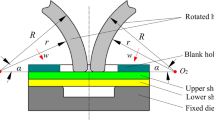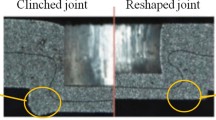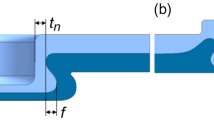Abstract
Mechanical clinching technology for joining aluminium alloy sheets has been a hot research topic in recent years. However, the clinched joint has a lower static strength than the welded joint and self-pierce riveted joint. In order to increase the strength of the clinched joint, a height-reducing method was investigated in the study. The material of the sheets is AL5052 which is widely used on the automotive body. Extensible dies were used to produce the clinched joint, while a flat die and a bumped die were used to produce the height-reduced joint. In the height-reducing process, the protrusion of the clinched joint was compressed by the flat die. The material of the protrusion flowed to the neck, which increased the strength of the joint by increasing the neck thickness. Different joints with different geometrical parameters were used to conduct the cross-tensile tests. The cross-tensile strength, energy absorption, failure mode and geometrical parameter of the joint are investigated. The results show that the cross-tensile strength and energy absorption of the joint can be increased by the height-reducing process. The main failure mode of the joints is neck fracture mode. The height-reducing method can increase the neck thickness with the decrease of the protrusion height. The height-reducing method was proved to be effective for increasing the strength of the clinched joint.
Similar content being viewed by others
References
Lambiase F, Di Ilio A (2014) An experimental study on clinched joints realized with different dies. Thin-Walled Struct 85:71–80
Varis JP (2002) The suitability of round clinching tools for high strength structural steel. Thin-Walled Struct 40:225–238
Mucha J (2011) The analysis of lock forming mechanism in the clinching joint. Mater Des 32:4943–4954
Mucha J (2014) The numerical analysis of the effect of the joining process parameters on self-piercing riveting using the solid rivet. Arch Civ Mech Eng 14:444–454
Mucha J, Kaščák L, Spišák E (2011) Joining the car-body sheets using clinching process with various thickness and mechanical property arrangements. Arch Civ Mech Eng 11(1):135–148
Mucha J, Witkowski W (2013) The experimental analysis of the double joint type change effect on the joint destruction process in uniaxial shearing test. Thin-Walled Struct 66:39–49
Lambiase F (2013) Influence of process parameters in mechanical clinching with extensible dies. Int J Adv Manuf Technol 66:2123–2131
Lambiase F, Di Ilio A, Paoletti A (2015) Joining aluminium alloys with reduced ductility by mechanical clinching. Int J Adv Manuf Technol 77:1295–1304
Eshtayeh MM, Hrairi M, Mohiuddin AKM (2016) Clinching process for joining dissimilar materials state of the art. Int J Adv Manuf Technol 82:179–195
Eshtayeh MM, Hrairi M (2016) Recent and future development of the application of finite element analysis in clinching process. Int J Adv Manuf Technol 84:2589–2608
Lee CJ, Kim JY, Lee SK, Ko DC, Kim BM (2010) Parametric study on mechanical clinching process for joining aluminum alloy and high-strength steel sheets. J Mech Sci Technol 24:123–126
Coppieters S, Cooreman S, Lava P, Sol H, Van Houtte P, Debruyne D (2011) Reproducing the experimental pull-out and shear strength of clinched sheet metal connections using FEA. Int J Mater Form 4:429–440
Coppieters S, Lava P, Baes S, Sol H, Van Houtte P, Debruyne D (2012) Analytical method to predict the pull-out strength of clinched connections. Thin-Walled Struct 52:42–52
Lambiase F, Di Ilio A (2016) Damage analysis in mechanical clinching: experimental and numerical study. J Mater Process Technol 230:109–120
Jiang T, Liu ZX, Wang PC (2015) Effect of aluminum pre-straining on strength of clinched galvanized SAE1004 steel-to-AA6111-T4 aluminum. J Mater Process Technol 215:193–204
Lee CJ, Kim JY, Lee SK, Ko DC, Kim BM (2010) Design of mechanical clinching tools for joining of aluminium alloy sheets. Mater Des 31:1854–1861
Lambiase F, Durante M, Di Ilio A (2016) Fast joining of aluminum sheets with glass fiber reinforced polymer (GFRP) by mechanical clinching. J Mater Process Technol 236:241–251
Lambiase F (2015) Clinch joining of heat-treatable aluminum AA6082-T6 alloy under warm conditions. J Mater Process Technol 225:421–432
Lambiase F (2015) Mechanical behaviour of polymer–metal hybrid joints produced by clinching using different tools. Mater Des 87:606–618
Lambiase F (2015) Joinability of different thermoplastic polymers with aluminium AA6082 sheets by mechanical clinching. Int J Adv Manuf Technol 80:1995–2006
Eshtayeh M, Hrairi M, Mohiuddin AKM (2016) Multi objective optimization of clinching joints quality using Grey-based Taguchi method. Int J Adv Manuf Technol. doi:10.1007/s00170-016-8471-1
Jiang T, Liu ZX, Wang PC (2015) Quality inspection of clinched joints of steel and aluminum. Int J Adv Manuf Technol 76:1393–1402
Abe Y, Mori K, Kato T (2012) Joining of high strength steel and aluminium alloy sheets by mechanical clinching with dies for control of metal flow. J Mater Process Technol 212:884–889
He XC, Zhao L, Yang HY, Xing BY, Wang YQ, Deng CJ, FS G, Ball A (2014) Investigations of strength and energy absorption of clinched joints. Comput Mater Sci 94:58–65
Saberi S, Enzinger N, Vallant R, Cerjak H, Hinterdorfer J, Rauch R (2008) Influence of plastic anisotropy on the mechanical behavior of clinched joint of different coated thin steel sheets. Int J Mater Form Suppl 1:273–276
He XC, Liu FL, Xing BY, Yang HY, Wang YQ, Deng CJ, FS G, Ball A (2014) Numerical and experimental investigations of extensible die clinching. Int J Adv Manuf Technol 74:1229–1236
Mucha J, Witkowski W (2014) The clinching joints strength analysis in the aspects of changes in the forming technology and load conditions. Thin-Walled Struct 82:55–66
Wen T, Wang H, Yang C, Liu LT (2014) On a reshaping method of clinched joints to reduce the protrusion height. Int J Adv Manuf Technol 71:1709–1715
Mucha J, Kaščák L, Spišák E (2013) The experimental analysis of forming and strength of clinch riveting sheet metal joint made of different materials. Adv Mech Eng 5:1–11
Chen C, Zhao SD, Han XL, Cui MC, Fan SQ (2016) Optimization of a reshaping rivet to reduce the protrusion height and increase the strength of clinched joints. J Mater Process Technol 234:1–9
Chen C, Zhao SD, Cui MC, Han XL, Fan SQ (2016) Mechanical properties of the two-steps clinched joint with a clinch-rivet. J Mater Process Technol 237:361–370
Chen C, Zhao SD, Cui MC, Han XL, Fan SQ (2016) Numerical and experimental investigations of the reshaped joints with and without a rivet. Int J Adv Manuf Technol. doi:10.1007/s00170-016-8889-5
Chen C, Zhao SD, Han XL, Cui MC, Fan SQ (2016) Investigation of mechanical behavior of the reshaped joints realized with different reshaping forces. Thin-Walled Struct 107:266–273
Mori K, Abe Y, Kato T (2012) Mechanism of superiority of fatigue strength for aluminium alloy sheets joined by mechanical clinching and self-pierce riveting. J Mater Process Technol 212:1900–1905
He XC, Zhang Y, Xing BY, Gu FS, Ball A (2015) Mechanical properties of extensible die clinched joints in titanium sheet materials. Mater Des 71:26–35
Xing BY, He XC, Wang YQ, Yang HY, Deng CJ (2015) Study of mechanical properties for copper alloy H62 sheets joined by self-piercing riveting and clinching. J Mater Process Technol 216:28–36
Zhao SD, Xu F, Guo JH, Han XL (2014) Experimental and numerical research for the failure behavior of the clinched joint using modified rousselier model. J Mater Process Technol 214:2134–2145
Author information
Authors and Affiliations
Corresponding author
Rights and permissions
About this article
Cite this article
Chen, C., Fan, S., Han, X. et al. Experimental study on the height-reduced joints to increase the cross-tensile strength. Int J Adv Manuf Technol 91, 2655–2662 (2017). https://doi.org/10.1007/s00170-016-9939-8
Received:
Accepted:
Published:
Issue Date:
DOI: https://doi.org/10.1007/s00170-016-9939-8




